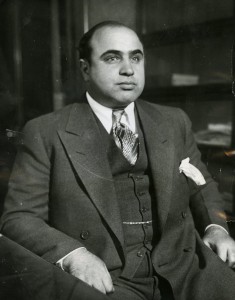Social Networking: Gangster Style
Social networks existed far before the age of Facebook, Twitter, and Instagram. In Prohibition-era Chicago, these networks existed in the form of organized crime, and no criminal network was more famous than Al Capone’s Chicago Outfit. The Outfit was the infamous Italian-American crime syndicate that fiercely contested other gangs for control over Chicago’s illegal alcohol market. Capone and his gang were, by nature of their activity, required to cover their tracks with the utmost care, presumably leaving little data behind. However, due to Capone’s legendary fame and a high profile federal trial, public interest in his dealings made it so troves of papers, records, legal proceedings and newspaper articles still survive in various Chicago archives. As a result, social scientists Chris M. Smith and Andrew V. Papachristos were able to leverage this wealth of data to discover the nature of links between the criminal underworld and the rest of the world in their paper, “Trust Thy Crooked Neighbor: Multiplexity in Chicago Organized Crime Networks.”
by nature of their activity, required to cover their tracks with the utmost care, presumably leaving little data behind. However, due to Capone’s legendary fame and a high profile federal trial, public interest in his dealings made it so troves of papers, records, legal proceedings and newspaper articles still survive in various Chicago archives. As a result, social scientists Chris M. Smith and Andrew V. Papachristos were able to leverage this wealth of data to discover the nature of links between the criminal underworld and the rest of the world in their paper, “Trust Thy Crooked Neighbor: Multiplexity in Chicago Organized Crime Networks.”
Smith and Papachristos scoured the archives collecting a huge amount of data, which was put into a relational database they designed. Their analysis of over 5,000 archival pages revealed about a 1,000 criminal connections involving Capone, whether direct or indirect. Intriguingly they also found a simultaneous network of personal relationships: friendship, business co-ownership, union or political co-membership. Having more than one kind of a relationship (i.e. criminal relationship and a friendship) between two people is a network property called multiplexity, which the authors found in 10% of the organized crime individuals. While scarce, these more robust relationships were incredibly important to the operation of the syndicate because they indicated mutual trust: crucial in a world where violence and backstabbing was the name of the game. The plot below shows the 1000 criminals analyzed, with each network delineated. The nodes with connection are black, and the non-connected nodes are light gray:

Notice the multiplex network (d) is significantly sparser (and contains a higher ratio of local/ near-local bridges) than the general criminal network (a). This not only implies trust was hard to come by in the syndicate, but also that weak ties (i.e. local bridges) were key conduits for trust. The authors argue that this “multiplexity glued the underworld and upper worlds together above and beyond the personalities of famous gangsters like Al Capone and general associations between ethnic groups. When networks and actions teeter into uncertain, unregulated, or risky domains, trusting your crooked neighbors may very well be critical—even if you trust only a few of them.” (Smith and Papachristos). In taking a novel approach to archival work, the authors illustrate the pervasiveness of networks. Capone himself would have killed for this insight.
___________________________________________________________________________________________
Sources:
Papachristos, Andrew V. and Smith, Chris M. “How network science unearthed the overlapping relationships of organized crime in Al Capone’s Chicago.” Published 31 Aug 2016. Accessed 11 Sept 2016. URL: http://bit.ly/2bRAef7
Papachristos, Andrew V. and Smith, Chris M. “Trust Thy Crooked Neighbor: Multiplexity in Chicago Organized Crime Networks.” American Sociological Review, August 2016 81: 644-667, first published on June 20, 2016 doi:10.1177/0003122416650149
Image Credits:
“Al Capone, 1930.” https://en.wikipedia.org/wiki/Al_Capone#/media/File:Al_Capone_in_1930.jpg
Networks plot is originally from the Smith and Papachristos paper listed above.
